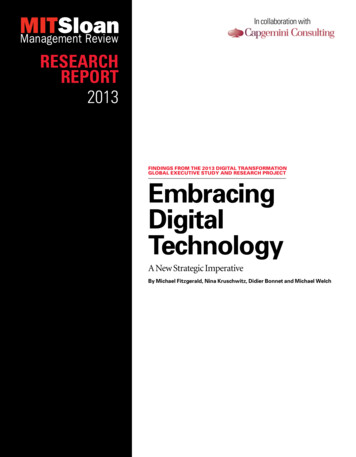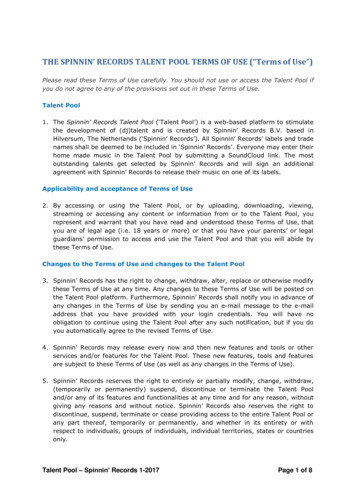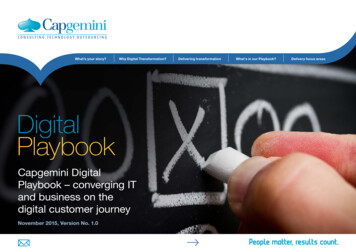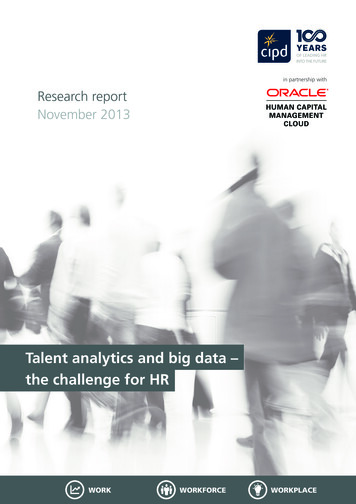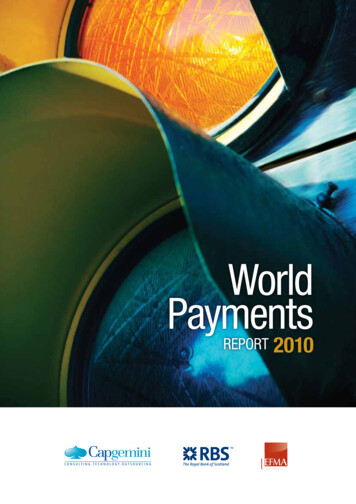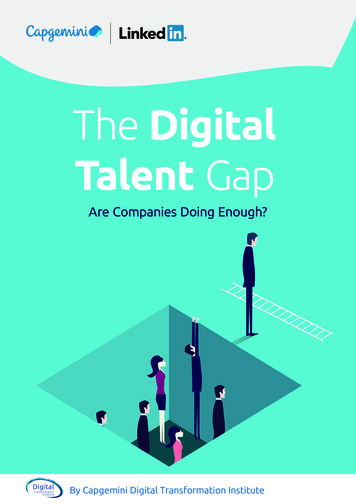
Transcription
The DigitalTalent GapAre Companies Doing Enough?DigitalTransformationInstituteBy Capgemini Digital Transformation Institute
2
The Digital Talent Gap—Are Companies Doing Enough?Nearly all organizations would agree that digital talent isimportant and that they are aware of the digital talent gap.Our pioneering research in collaboration with LinkedInhowever, suggests that although the majority of companiesfrequently discuss this gap, concrete action to bridge it israrely taken. Close to 50% of the organizations we studiedconceded they have not taken digital talent seriously.To probe this issue, we undertook a worldwide, crosssector research program in collaboration with LinkedIn. Wesurveyed over 1,250 people to gain the perspectives of bothemployees and leadership teams and we interviewed humanresource and talent executives within organizations as well asdigital and technology recruiters. In parallel, we worked withLinkedIn to understand demand and supply for specific digitalskills and digital roles. The research methodology at the endof the report provides more detail on our approach.In this paper we:1.Identify key trends and changes in the digital talent gaparena and pinpoint the digital skills and digital roles ingreatest demand in “The digital talent gap is widening”2. Assess the key challenges that are preventingorganizations from bridging the talent gap by exploringemployees’ views in “Key talent roadblocks: theemployees’ perspective”3. Outline the best practices we can learn from leadersin the digital talent arena in “Proactive digital talentleaders have valuable lessons to offer”4. Recommend strategies to more effectively recruit,develop, and retain digital talent in “What canorganizations do to narrow the digital talent gap?”With ever-increasing demand for skills, the talent gap haswidened. The challenge of the digital talent gap is no longerjust an HR issue; it is an organization-wide phenomenon thataffects all areas of the business. The objective of this report isto guide Chief HR officers, other CXOs, and the Learning andDevelopment (L&D) teams in addressing this challenge.3
Executive Summary—Key TakeawaysThe digital talent gap is widening. Everysecond organization we surveyed acknowledgedthat the digital gap is widening. Moreover,over half (54%) of the organizations agreedthat the digital talent gap is hampering theirdigital transformation programs and that theirorganization has lost competitive advantagebecause of a shortage of digital talent.The talent gap in soft digital skills is morepronounced than in hard digital skills. Moreemployers (59%) say that their organizationlacks employees who possess soft digital skillsthan hard digital skills (51%). The two soft digitalskills in most demand are customer-centricityand passion for learning and the two hard digitalskills in most demand are cybersecurity andcloud computing.Many of today’s employees are anxious.Employees are worried that their skills areeither already redundant or soon to become so.Overall, 29% of employees believe their skill setis redundant now or will be in the next 1–2 years.Employees feel organizations’ trainingprograms are not hugely effective and thosewho want to excel are looking beyond theirorganizations’ learning and development(L&D). More than half of today’s digital talentsay that training programs are not helpful orthat they are not given time to attend. Close tohalf actually describe the training as “uselessand boring.” Nearly 60% of digital talent areeven investing their own time and money, mostcommonly to be on a par with their colleagueson the required digital skills.Skill redundancy fears and lack of faith intheir organization’s upskilling efforts couldtrigger attrition. Over half of digital talent(55%) say they are willing to move to anotherorganization if they feel their digital skills are4The Digital Talent Gapstagnating at their current employer. And overhalf of digital talent (58%) are likely to gravitatetowards organizations that offer better digitalskill development. Furthermore, digital talenthave an easy exit option as they are faced withan abundance of job opportunities.What can organizations do tonarrow the digital talent gap?In an increasingly digital economy, thoseorganizations that bridge the talent gap willenjoy a competitive edge over those who don’t.A defined digital talent strategy that meetsboth business objectives and the needs andpreferences of digital talent is critical for asustainable and successful digital transformation.Based on what we have learned from ourresearch—as well as our experience in the fieldwith our clients—we believe there are six areasorganizations should focus on to solve theirdigital talent challenges:Attracting Digital Talent Align leadership on a talent strategy and theunique needs of digital talent Diversify recruiting approachDeveloping Digital Talent Create an environment that prioritizes andrewards learning Chart a clear career development pathRetaining Digital Talent Give digital talent the power toimplement change Provide flexible and collaborative waysof working.
What is digital talent?In our survey, we analyzed digital talent in three ways: Hard digital skills (such as data analytics) Soft digital skills (such as comfort with ambiguity) thatconstitute a “digital-first mindset” and are necessary fora successful digital transformation Digital roles that have been created as a result of digitaltransformation activities within an organization or theemergence of disruptive technologies.Twenty-four hard digital skills, eight soft digital skills, andtwenty-three digital roles were included in our survey andwere identified based on both long-standing and emergingtechnologies and on our extensive experience inthe digital transformation space. Please refer to theAppendix for a full listing.We created the profile of a Digital Talent employee who isproficient in at least one of the 24 hard digital skills and inat least four of the eight soft digital skills included in oursurvey. Such employees constitute over half (56%) of thosesurveyed. “Footprint of Digital Talent” on page 10 outlinestheir defining characteristics.We also identified together with LinkedIn a furtherlong list of hard digital skills and digital roles based on amutually agreed definition for “digital.” Please refer to theResearch Methodology for further details.5
55% PercentageThe digital talent gapis wideningEvery second organization we surveyed acknowledgedthat the digital gap is widening. Moreover, over half (54%)of the organizations agreed that the digital talent gap isof organizations whoacknowledge thatthe digital talent gapis wideninghampering their digital transformation programs and thattheir organization has lost competitive advantage because ofa shortage of digital talent (see Figure 1).Figure 1. More than half of organizations still face a shortage of digital talent and say it affects their competitivenessPercentage of organizations that acknowledge the shortage of digital talentMy organization faces a gap in soft digital skills(lacks qualified individuals in soft digital skills)The digital talent gap in my organization hasbeen widening over the past couple of yearsMy organization faces a gap in hard digital skills(lacks qualified individuals in hard digital skills)59%55%51%Percentage of organizations that acknowledge the impact of the digital talent gapThe digital talent gap is hampering our digitaltransformation programs54%My organization has lost competitive advantageowing to a shortage of digital talent54%Source: Capgemini Digital Transformation Institute survey, Digital Talent Gap; June–July 2017, N 501 employers.6The Digital Talent Gap
The percent of organizations that say the digital talent gaphas widened is above the global average in the United States,India, and the United Kingdom. By industry sector, thewidening gap is more pronounced in the banking, consumerproducts, retail, and insurance industries (see Figure 2).Figure 2. Seven in ten organizations in the US cite a widening talent gap while six in ten banking organizationsalso acknowledge itPercentage of organizations responding to widening of digital talent gap,by geographyUnited States70%64%IndiaUnited yNetherlands43%34%55%GlobalThe digital talent gap in my organization has been widening over the past couple of yearsPercentage of organizations responding to widening of digital talent gap, by industryBanking62%Consumer tiesTelecomGlobal48%42%55%The digital talent gap in my organization has been widening over the past couple of yearsSource: Capgemini Digital Transformation Institute survey, Digital Talent Gap; June–July 2017, N 501 employers.7
The talent gap in soft digital skills is morepronounced than in hard digital skillsSoft digital skills are an increasingly important characteristicof a well-rounded digital professional (see “What is digitaltalent?”). As Figure 1 shows, more employers (59%) say thattheir organization lacks employees who possess soft digitalskills than hard digital skills (51%). As Wendy Murphy, SeniorDirector, Human Resources, Europe, Middle East and Africa atLinkedIn puts it, “Soft digital skills are required across all levels,especially the ability to learn and to be agile. Both attributescombined are hugely important in terms of making stridesforward in the digital world. We do not know what the futurelooks like, therefore, having people who have the resilience andability to shift from one thing to another with ease and learnconstantly to help the business progress, is immensely important.”Figure 3 shows the talent gap in soft skills, representingthe difference between employer demand for the skilland employee proficiency. The two skills in most demandare customer-centricity and passion for learning, whilethe greatest gap exists for comfort with ambiguityand collaboration.Figure 3. There is a gap between what organizations need and the proficiency of their employees in almost all soft digital skills1Percentage of organizations that acknowledge that demand for a soft digital skill is high in theirorganization today and percentage of employees who are proficient in that soft digital skill65%Customer- centricity57%64%Passion for learning65%63%Collaboration52%62%Data-driven decision making55%61%Organizational dexterityComfort with ambiguity56%56%43%54%Entrepreneurial mindsetChange managementEmployer: Demand for this digital skill ishigh in my organization today51%53%44%Employee: Proficiency–level of skillSource: Capgemini Digital Transformation Institute survey, June–July 2017, N 501 employers; N 753 employees; ranked by employer demand.I think that the world is focused very heavily on hard skills like computer science,data science, and artificial intelligence. Let us be clear those skills are very important.However, the combination of hard skills and power skills, like communications, criticalthinking, and teamwork, is most vital. These skills are required in every job and are criticalfor professional success across all industries.”Anant Agarwal, Founder and CEO of eDX, a massive open online course (MOOC) provider8The Digital Talent Gap
Demand for hard digital skills still outpaces supplyAs Figure 1 shows, more than half of organizations face atalent gap in hard digital skills. The two skills in most demand,cybersecurity and cloud computing, are also those with thegreatest talent gap (see Figure 4).Figure 4. A stark gap exists between organizations’ requirements and employee proficiency for hard digital skillsPercentage of organizations that acknowledge that demand for a hard digital skill is high in theirorganization today and percentage of employees who are proficient in that hard digital skill68%Cybersecurity43%65%Cloud computing42%64%Analytics51%64%Web development39%62%Mobile application design and development38%62%Data science45%61%Big data41%61%Master data management42%61%Innovation strategy40%60%User interface design39%Employer: Demand for this digital skill ishigh in my organization todayEmployee: Proficiency–level of skillSource: Capgemini Digital Transformation Institute survey, June–July 2017, N 501 employers; N 753 employees; ranked by employer demand.Top digital roles in the next 2–3 yearsWe asked employers which digital roles will be more prominent in the near future. As highlighted in Figure 5, securityand data roles top the list.Figure 5. Top 10 digital roles of the next 2–3 years1.2.3.4.5.Information security/Privacy consultantChief digital officer/Chief digital information officerData architectDigital project managerData engineer6.7.8.9.10.Chief customer officerPersonal web managerChief internet of things officerData scientistChief analytics officer/Chief data officerSource: Capgemini Digital Transformation Institute survey, June–July 2017, N 501 employers.9
Footprint ofdigital talentIndia has the highest proportion* of digital talent76%India66%65%Italy62%Spain61%United ny56%38%SwedenGlobalSource: Capgemini Digital Transformation Institute Survey, Digital Talent Gap; June–July 2017, N 425 digital talent employees.*Proportion represents the percentage of digital talent out of 100 in that particular country or industryAutomotive and Consumer Products have the highest proportion* of digital talent64%63%Automotive Consumer lecomRetailSource: Capgemini Digital Transformation Institute Survey, Digital Talent Gap; June–July 2017, N 425 digital talent employees.*Proportion represents the percentage of digital talent out of 100 in that particular country or industryAgile, Web, and Cloud are the most common hard digital skills2. Web development1. Agile methodologies3. Cloud computing4. Search engine optimization5. AnalyticsTop 5 hard digital skills digital talent list on their LinkedIn profile**Source: Aggregated LinkedIn member profile data, Digital Talent Gap; June–July 2017; **Top 5 skills fromLinkedIn profile data for members with the 24 hard digital skills included in the survey10The Digital Talent Gap56%Global
Key talent gap roadblocks:The employees’ perspectiveMany of today’s employees are anxious. They are worried thattheir skills are either already redundant or soon to become so.Overall, 29% of employees believe their skill set is redundantnow or will be in the next one to two years and over a third(38%) believe their skill set will be redundant in the next fourto five years (and 47% of Gen Y and Gen Z employees)2 (seeFigure 6). Digital talent are even more anxious about theirskills —33% of them believe their skill set is redundant now orwill be in the next one to two years and 44% believe their skillset will be redundant in the next four to five years.47% Percentage of Gen Y andGen Z employees who considertheir skill set is redundant or willbe redundant in the next four tofive yearsFigure 6. Employees across countries and industries believe their skill set is or will be redundantPercentage of employees believing their skill set is redundant now or will be redundant, by eMy current skill set is redundant now or in the next 1–2 yearsUnitedUnitedGlobalSwedenKingdomStatesMy current skill set will be redundant in the next 4–5 yearsGermanyPercentage of employees believing their skill set is redundant now or will be redundant, by tailConsumer ProductsGlobalMy current skill set is redundant now or in the next 1–2 yearsMy current skill set will be redundant in the next 4–5 yearsSource: Capgemini Digital Transformation Institute survey, Digital Talent Gap; June–July 2017, N 753 employees; ranked by gap.11
42% Percentage of employees whodescribe their organization’s trainingprograms as “useless and boring”However, while employees worry about the future and clearlyfeel the need to keep their skills current, many do not look totheir employers’ learning and development for answers:they are not given time to attend. Close to half actuallydescribe the training as “useless and boring” (see Figure 7).Instead, employees are looking outside the organization.In fact, 52% of all the employees prefer learning througha massive open online course (MOOC) than theirorganization’s training program. Employees feel organizations’ training programs arenot hugely effective. More than half of today’s digitaltalent say that training programs are not helpful or thatFigure 7. Around half of the employees are not satisfied with their organizations’ trainingsPercentage of employees responding to "I do not show interest inmy organization’s training programs because."52%The training programs designed by my organizationare not helping me gain new digital skills45%52%I am not given the time and resources toattend digital skills training48%45%Most training programs I attend areuseless and boringDigital Talent42%All employeesSource: Capgemini Digital Transformation Institute survey, Digital Talent Gap; June–July 2017, N 425 digital talent employees; N 753employees; ranked by gap. Employees who want to excel are looking beyond theorganizations’ L&D programs. Digitally talented employeesare even investing their own time and money(see Figure 8). Speaking about the benefits of a MOOCprovider, one employee said, “I needed a stepping stone toenter into a new field and wanted to accomplish this withouthaving to scale back my responsibilities at work or take aprolonged break from my career. Hence, I opted for onlinelearning. With online programs one has the ability to be one’sown boss by setting your own schedule and going at yourown pace.”12The Digital Talent GapDarren Shimkus , General Manager, Udemy, a learningplatform, believes this is part of a shift to employeedriven learning. “Corporate learning programs were allbased on what the company thought an employee shouldknow,” he says. “Now we are seeing much more employeedriven learning. Employees can decide. ‘Do I need to learnthe principles of data science to do my job? Do I need to learndigital marketing campaigns to do my job?’ Employees are theones who really understand what skills they need in order toaccomplish their goal or to get to the next level in their career.”
Figure 8. Employees invest their own resources to develop digital skillsEmployees responding to "Have you invested in developing digital skillson your own (i.e. with your own money or on your on time)?"Digital TalentAll employees42%52%58%48%YesNoThe top three reasons that motivate digital talentto invest in digital skills on their own38%23%I want to be on a parwith my colleagues onrequired digital skillsFlexibility to chooseprograms as per myarea of interest19%Interest in expandingdigital skills that willhelp me in my personal,not professional lifeSource: Capgemini Digital Transformation Institute survey, Digital Talent Gap; June–July 2017, N 425 digital talent employees; N 753employees; Percentages for the lower chart do not sum to 100 as only the top three reasons are listed.13
Organizations need to pay attention to thewidening gap or risk losing existing talent Skill redundancy fears and lack of faith in theirorganization’s upskilling efforts could triggerattrition. Over half of digitally talented employees (55%)(and 53% of Gen Y and Gen Z employees) say they arewilling to move to another organization if they feel theirdigital skills are stagnating at their current employer.And over half of digital talent (58%) are likely to gravitatetowards organizations that offer better digital skilldevelopment (see Figure 9).Figure 9. Digital skills and learning environment could cause six out of ten employees to switch jobsEmployee preferences while switching jobs55%My next job change will be because my digitalskills are stagnating at my current organization43%58%My next job change will be because the neworganization offers better digital skill developmentDigital Talent47%All employeesSource: Capgemini Digital Transformation Institute survey, Digital Talent Gap; June–July 2017, N 425 digital talent employees; N 753employees; ranked by gap.55% Percentage ofdigitally talented employeeswho say they are willing toswitch jobs if they feel theirdigital skills are stagnating14The Digital Talent Gap
What attributes do digital talent value?Eight out of ten digital talent employees prefer joiningorganizations that allow a flexible work-life balance.Seventy-five percent of digital talent prefer joiningorganizations with a flat hierarchy and accessiblemanagement as well as an open and collaborative physicalworkspace (see Figure 10).Figure 10. A flexible work-life balance and a flat hierarchy rank high on digital talent’s preferences whenswitching organizationsPercentage of employees who agree with "I prefer joining organizations. "79%That allow a flexiblework-life balance71%With a flat hierarchy andaccessible management63%That have an open and collaborativephysical work space63%75%75%Where I have a clear careerdevelopment path74%62%Known for theirupskilling/training programs73%63%That have an entrepreneurial, "start-up" likeculture that promotes agility and flexibility72%61%That offer opportunities to engagewith the local community72%62%Where the leaders are committed to developingand executing digital transformation programs71%59%Where my peer group wouldbe digitally talented57%Known for attracting topdigital talent57%71%68%That are located in urban areasand/or technology hubsDigital Talent62%51%All employeesSource: Capgemini Digital Transformation Institute survey, Digital Talent Gap; June–July 2017, N 425 digital talent employees; N 753employees; ranked by digital talent preferences.15
Digitally talented employees have an easy exitoption as they can count on an abundance of jobopportunities. Based on aggregated member profiledata from LinkedIn, on average, Data Scientists and FullStack Developers have the highest demand index over thepast year3. Each Data Scientist on average received 13.2InMails over the past year and each Full Stack Developer onaverage received 11.2 InMails over the past year(see Figure 11).Businesses need to recognize thatdigital talent is a small pool ofpeople who have a lot of goodoffers competing for their attention.Companies may not be able to engagethese people in the same manner as atypical employee base; they need to beclever in their approach.”Tuck Rickards,Managing Director at Russell ReynoldsFigure 11. Data Scientist and Full Stack Developer rank high on demand index on a global level*Demand index* for top 10 digital roles13.2Datascientist11.2Full .55.2Integration Information igitalprojectmanager4.13.0Solutions TechnologyarchitectarchitectSource: Aggregated LinkedIn member profile data, Digital Talent Gap; June–July 2017. *Top 10 roles based on aggregated LinkedIn data formembers with the 23 digital roles included in the survey.13.2 Number ofInMails each Data Scientistreceived over the past yearon average16The Digital Talent Gap
17
Geographic Supply and Mobility Trends ofDigital TalentIn our partnership with LinkedIn, we looked at supply andmobility trends for digital talent across selected countriesbased on a longer list of mutually agreed digital titles. India,the United Kingdom, and Germany have the largest supplyof digital talent per 10,000 total members in the country.Spain has the lowest supply among the countries in oursurvey.Figure 12. India ranks the highest in digital talent95111GermanyUnited KingdomIndia72Netherlands44ItalySweden5676United States8788France42SpainNumber of digital talent members per 10,000 members in that countrySource: Aggregated LinkedIn member profile data, Digital Talent Gap; June–July 2017; data based on the long list of digital titlesmutually agreed upon.We defined a migration ratio that gives the movement inand out of a country, i.e., the number of members movinginto this particular country for every one person whomoves out. A migration ratio of 1.5X means 15 membersare moving into that country while 10 move out.As Figure 13 shows, the United States, Germany, andSweden are the top three countries with a migration ratioof more than one. This indicates that these countries arethe top preferred destinations for digital talent. On theother extreme, India has one of the lowest migration ratiosof 0.4. In other words, for every ten digital talent movingfrom India to other locations, only four are moving to India.18The Digital Talent GapFigure 13 also shows the inward and outward movement ofdigital talent for each of the countries. India is part of theinflow for all the top three preferred nations (US, Germany,and Sweden). An Assistant Vice President of an insurancefirm outlines how India has become a major source of talent.“India is our biggest source of digital talent,” he says. “While mostof our business comes from Europe, we are facing a dearth ofdigital talent there. Asia—and India in particular—is the placewhere we will get this talent. It might be because of the boomin e-commerce and technology in India .younger talent hasstarted showing an active interest which is fueling the digitaljourney even further.”
Figure 13. The United States followed by Germany have the most digital talent moving into the country thanthose moving outUnited StatesIndia (47%)GermanyIndia (28%)UK (6%)UK (7%)Canada (6%)Canada (5%)1.60 16 digital talent move to the USwhile 10 move outUS (10%)US (12%)UK (9%)UK (11%)India (9%)Switzerland (9%)1.58 15.8 digital talent move to Germanywhile 10 move outSwedenNetherlandsGermany (12%)India (13%)India (14%)US (13%)UK (11%)US (10%)1.44 14.4 digital talent move to Swedenwhile 10 move outUnited KingdomUK (25%)US (10%)Germany (8%)France (7%)1.2 12 digital talent move to Spain while10 move outIndia (16%)US (10%)Australia (7%)US (13%)India (12%)Australia (10%)1.06 10.6 digital talent move to the UKwhile 10 move outItalyFranceUK (20%)US (13%)UK (12%)Tunisia (6%)US (9%)1.36 13.6 digital talent move to theNetherlands while 10 move outSpainUK (20%)US (7%)UK (11%)UK (11%)US (7%)UK (14%)US (13%)US (11%)UK (25%)Germany (9%)US(8%)Switzerland (8%)0.84 8.4 digital talent move to Francewhile 10 move outIndiaUS (47%)UK (14%)UAE (6%)0.67 6.7 digital talent move to Italy while10 move outInward movement: Share of this particularcountry out of the total inward populationto the countryUS (50%)Australia (8%)UK(8%)0.40 4 digital talent move to India while10 move outOutward movement: Share of this particularcountry out of the total outward populationfrom the countryMigration ratio: Ratio of movement of LinkedInmembers in and out of a countrySource: Aggregated LinkedIn member profile data, Digital Talent Gap; June–July 2017; data based on the long list of digital titlesmutually agreed upon.19
Additional challenges that prevent organizationsfrom bridging the digital talent gapIn addition to employees’ views on why organizationsfail to tackle the digital talent gap, we have identified anumber of reasons from employers themselves as to whythey are struggling: They are not making sufficient investments. Eventhough the talent gap has widened, budgets for trainingdigital talent have remained flat or decreased in morethan half of the organizations (see Figure 14).Figure 14. Organizations’ efforts in mitigating the digital talent gap are inadequateHow are organizations dealing with the digital talent gapMy organization needs to increase its budgetssignificantly for developing required digital talent62%While the digital talent gap has widened in the past fewyears, our training budget has remained flat or decreased52%We lack required support frommanagement to attract digital talent50%We keep talking about the digital talent gapbut not much is being done to bridge it50%Source: Capgemini Digital Transformation Institute survey, Digital Talent Gap; June–July 2017, N 501 employers. They are worried about attrition for upskilled staffand there is employee resistance. Organizationsface a mammoth task in terms of digital upskilling.Half of employers fear their employees will leave theirorganization after they receive training and half saytheir digital skills trainings are not well attended(see Figure 15).Figure 15. Organizations cite possible attrition and lack of attendance as challenges for upskillingChallenges faced in upskillingOur employees leave the organizationsoon after being trained on digital skills51%Our trainings on digital skillsare not well attended50%Employees show resistance tolearning new skill sets48%Source: Capgemini Digital Transformation Institute survey, Digital Talent Gap; June–July 2017, N 501 employers. They take a reactive approach. As Figure 16 shows, mostorganizations continue to take a reactive approach toupskilling digital talent. Less than one-fifth of organizationsupskill their employees by both filling current needs andstrategically planning for future requirements.For the organizations that are proactive, consistencyis key. Wendy Murphy of LinkedIn says, “LinkedIn doesnot have a massive digital talent gap right now becausewe have been very forward-thinking. We have built talentfrom within as well as externally with data-driven decisionsleveraging our own platform which may have placed usahead of the game versus other traditional organizations.However, no company can sit on their laurels. Organizationsneed to be consistently innovating and planning.”Figure 16. Very few organizations take a proactive approach to upskilling talentUpskilling strategy followed by organizationsWe upskill every year based on current needs and futurerequirements for the upcoming yearWe upskill every three to six months based o
skills and digital roles. The research methodology at the end of the report provides more detail on our approach. With ever-increasing demand for skills, the talent gap has widened. The challenge of the digital talent gap is no longer just an HR issue; it is an organization-wide phenomenon that affects all areas of the business.
